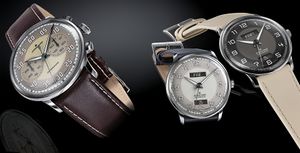Junghans: At the wheel of time
Press release
Schramberg, February 2017
At the wheel of time
The Meister Driver Day Date from Junghans incorporates optical elements from historical instrument displays in its design.
Automobile design
Steel chassis and hand-wrought struts, surrounded by a streamlined body with flowing wings. The cars of the 1930s continue to fascinate aficionados around the world to this day. It is the era in which higher speeds and longer distances make the speedometer increasingly important, whilst the cockpit itself begins to feature a clear arrangement of instruments. One element on the dashboard is the speedometer, with its total and daily tally of kilometres. These small details from the historical role models are incorporated into the new Meister Driver Day Date, in turn establishing a link to the Meister Driver of 2016.
Yesterday, today and tomorrow in view
The designers at Junghans have drawn inspiration from the display of total and daily kilometres in creating the Meister Driver Day Date: the day and date displays are in the form of rotating columns – a nod to the automobile role model. The unique form of this display, which features semi-transparent surfaces to the side of the actual date and weekday display, is enabled by individual printing in the in-house dial printing facility. The colour scheme of the timepiece is also inspired by the tachometers of the 1930s: a refinement with polished paintwork conveys a very special flair. With a diameter of 40 mm, the new Meister Driver Day Date is a three-handed watch with an independent character.
Junghans Meister Driver – passion and the pioneering spirit
The strong links between Junghans and the automobile have been in place since the end of the 19th century. Arthur Junghans, son of the company founder Erhard Junghans, was a close friend of Gottlieb Daimler and Wilhelm Maybach. As a consequence, he bought one of the first Daimler test cars in 1892. Just three years later Arthur Junghans ordered a four-seater Motor-Viktoriawagen, for which he created worm gear steering. At the beginning of the 20th century the company produced car clocks. Numerous inventions were also made – in 1905 Dr. Oskar Junghans, son of Arthur Junghans, developed a speed measuring device with integral speed logging. His brother Helmut shared his passion for the automobile. In 1924 he developed a "Viadicator" driving direction indicator in co-operation with the Leitz company of Wetzlar, a predecessor of the present-day indicator. More than a century of affinity for the automobile is continued today by the Junghans owners, Dr. Hans-Jochem and Hannes Steim. The Steim car collection in Schramberg, which celebrates its 10th birthday in 2017, contains a cross section from over 110 years of automobile history – with stylish classic vehicles that serve as inspiration for the models of the Meister Driver series, bringing this passion to the wrist.
Junghans – The German watch
Junghans was founded in the Black Forest town of Schramberg in 1851. Over 150 years of expertise in precision and design is reflected in memorable milestones: In 1093 Junghans was the largest watch manufacturer in the world, with over 3,000 employees. The development of precision movements made the company the largest German manufacturer of chronometers in 1951 and the third largest worldwide in 1956. In 1972 Junghans was the official timekeeper of the Olympic Games in Munich, setting new standards in timekeeping. After an eventful and turbulent company history, the Schramberg entrepreneurs Dr. Hans-Jochem and Hannes Steim became the new owners of the venerable company in 2009. Each watch is produced in Schramberg with great attention to detail, technological expertise and high standards of design and quality. The collection comprises charismatic timepieces: The Meister watches, which have been produced since the 1930s, reflect the history and present of the company. In 1956 Max Bill designed watches that have become absolute classics. Distinguished by the Bauhaus philosophy, they are still produced today in nearly unchanged form. Junghans set new standards in 1990 with the invention of the radio-controlled wristwatch – a technology that is still used today, in combination with environ-mentally-friendly solar power. A wide variety of technology as unique as the watches bearing the star.



